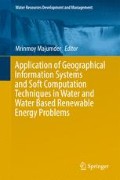Abstract
The purpose of this review is to summarize the current standard of practices for estimating reservoir sediment inflows for the entire duration of their useful service life, normally 100-year ARI design period. To achieve this objective, a review of the past and contemporary literatures and conventions on sedimentation issues in Malaysia as well as other regional countries is imperative. A case study was carried out using the proposed Teriang reservoir. (CA = 59 km2) that is located mainly in the forested headwater region of Sg. Teriang which eventually joins Sg. Pahang further downstream in the state of Pahang, Malaysia. Both the low and high (Type I and II respectively) curves are adopted for predicting the suspended load concentration (mg/l) using normalized flow discharge per unit area (Q/km2; m3/s/km2). Alternative method by coupling the sediment rating and flow duration curve (both daily and monthly) are also used for checking purpose. The limitations and insights of total sediment loadings estimates for the case study are discussed in order of importance.
Access this chapter
Tax calculation will be finalised at checkout
Purchases are for personal use only
References
American Society of Civil Engineers. (1975). Sedimentation engineering. Manuals and reports on engineering practice No. 54. NY. NY.
Balamurugan, G. (1991). Some characteristics of sediment transport in the Klang River Basin. Journal of the Institutions of Engineers Malaysia, 48, 31–52.
Binnie dan Rakan. (1980). Study on siltation at Pedas impounding dam. Final Report, JBANS, Kerajaan Negeri Sembilan.
CIGB-ICOLD. (1989). Sedimentation control of reservoirs: Guidelines. Bulletin (Vol. 67), Paris, France.
Chan, N. W. (1998). Development of hill land and its effects on hydrology and water resources in Penang. In Humid tropic, November 24–26, 1998. Ipoh, Malaysia.
Douglas, I. (1999). Hydrological investigations of forest disturbance and land cover impacts in Southeast Asia: A review. Philosophical Transactions of the Royal Society of London B: Biological Sciences, 354, 1725–1738.
Douglas, I., Bidin, K., Balamurugan, G., Chappel, N. A., Walsh, R. P. D., Greer, T., et al. (1999). The role of extreme event in the impacts of selective tropical forestry erosion during harvesting and recovery phases at Danum Valley, Sabah. Philosophical Transactions of the Royal Society of London B: Biological Sciences, 354, 1749–1761.
Ekran Bhd. (1995). Detailed environmental impact assessment: privatization of Bakun Hydroelectric project. Appendix 3A, physical environment of the Bakun catchment. Final report.
Electrowatt and SMHB. (1993). Murum hydroelectric project: Phase I report. Sarawak Electricity Supply Corporation (SESCO), Sarawak.
Jurutera Jasa and SMHB. (2001). The proposed Gerugu dam, Sarikei, Sarawak. Final design report. Jabatan Kerja Raya, Sarawak
K.K. Projek Konsultant/SMHB Sdn. Bhd. (1992). Kota Kinabalu water supply extension scheme: Stage 2. Final report. JBA, Negeri Sabah.
Lai, F. S., & Akkharath, L. (2002). Suspended sediment yield changes resulting from forest harvesting in the Sg. Weng Experimental Watershed, Kedah, Peninsular Malaysia. In International Conference on Urban Hydrology 2002, October 14–16, 2002, Kuala Lumpur, Malaysia.
Lai, F. S. (1993). Sediment yield from logged, steep upland catchment in Peninsular Malaysia. In Hydrology in warm humid regions. IAHS Publication No. 216, pp 219–230.
McCuen, R. H. (1998). Hydrologic analysis and design (2nd ed.). New Jersey: Prentice Hall.
Mohd. Fuad, O., & Kamaruzaman, M. (1992). Mitigation of reservoir deposition through watershed management with special reference to hydropower scheme. In Seminar on methods for preservation of useful reservoir storage on heavily sediment laden rivers, October 12–16, 1992, Kuala Lumpur, Malaysia.
Mohd Amin, M. (1992). Partial restoration of reservoir capacity by periodic flushing and mechanical means. In Seminar on methods for preservation of useful reservoir storage on heavily sediment laden rivers, October 12–16, 1992, Kuala Lumpur, Malaysia.
SMEC and SMHB. (1988). Pergau hydroelectric project: feasibility study, vol 3: Hydrology. Final report, LLN and EPU, Government of Malaysia.
SMEC. (1976). Terengganu River Basin study: Feasibility report on multi-purpose dam project. Final Report (Vol. 3): Hydrology, EPU, Government of Malaysia.
SMHB/SMEC/SGV-KC. (1984). Water resources development for East Negeri Sembilan, Melaka, Northeast Johor. Final Report, EPU, Kerajaan Malaysia.
SMHB Sdn. Bhd. (1992). Study on comprehensive water resources planning and development in the State of Pahang (Vol 3: Chaps. 5 and 6). Final Report, EPU, Government of Malaysia.
SMHB Sdn Bhd. (1994). Study of comprehensive water resources planning and development in the State of Johor. Government of Johor: Final Report.
Sepakat Setia Perunding/Mott MacDonald. (1993). Preliminary EIA, detailed engineering investigation, detailed design and supervision of construction of the Sg. Kelinchi dam and transfer tunnel. Conceptual design Report, JBA, Negeri Sembilan
Tew, K. H., & Faisal, A. (2003). Near real time soul erosion risk assessment and an early warning system. Bulletin Ingenieur, 19, 21–25.
Notes: Secondary Sources
Peh, C. H. (1980). Runoff and sediment transport by surface wash in three forested areas of Peninsula Malaysia, Malay. Forester, 43, 56–67. Sg. Tekam catchment (CA = 0.57 km2) 270 tonnes/km2/year; forested land use.
Shallow, papers. (1956). No full reference. Mostly in the Cameron highland, Sg. Telom (CA = 77 km2); Sg. Kial (CA = 21 km2) and Sg. Bertam (CA = 73 km2), the rate quoted was 300 tonnes/km2/year.
Author information
Authors and Affiliations
Corresponding author
Editor information
Editors and Affiliations
Rights and permissions
Copyright information
© 2018 Springer Nature Singapore Pte Ltd.
About this chapter
Cite this chapter
Hii, C.P., Heng, H.H. (2018). Review of Reservoir Sediment Inflow Estimation for Teriang Reservoir, Malaysia. In: Majumder, M. (eds) Application of Geographical Information Systems and Soft Computation Techniques in Water and Water Based Renewable Energy Problems. Water Resources Development and Management. Springer, Singapore. https://doi.org/10.1007/978-981-10-6205-6_1
Download citation
DOI: https://doi.org/10.1007/978-981-10-6205-6_1
Published:
Publisher Name: Springer, Singapore
Print ISBN: 978-981-10-6204-9
Online ISBN: 978-981-10-6205-6
eBook Packages: Earth and Environmental ScienceEarth and Environmental Science (R0)

